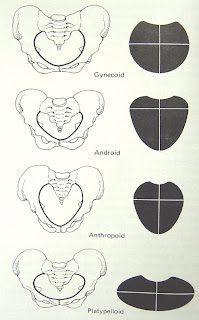Sunday, March 15, 2015
Anatomy of Female Reproductive System
Case: A 27 year old lady comes to your clinic with complaints of pain abdomen for 2 days and nausea and vomiting for 5days which is more in the morning. She also complains of increased frequency of micturition for a week. Her last menstrual period was 6 weeks back. On examination you find no abnormality except for slight breast tenderness. Per speculum and per vaginal examinations are normal. What investigation would you like to order the first?
Introduction
External genitalia
Internal genitalia
Vessel and nerve and lymph
Adjacent organs
Pelvis
Pelvic floor
External genitalia
Labia majora
- The venous drainage is extensive and forms a plexus with numerous anastomoses. Vulva hematoma
Vaginal vestibule
- Bordered by the labia minora laterally, by the urethra and clitoris anteriorly, by the hymenal ring inferiorly.
Internal genitalia



Vagina
1.Strong canal of muscle (7.5cm)
extend from the uterus to the vestibule of the external genitalia. its long axis is almost parallel with that of the lower part of the sacrum. the anterior wall of the vagina is 1.5-2cm shorter than the posterior wall.
2.vaginal fornix
the circular cul-de-sac formed around the cervix
4 regions: the anterior fornix, the posterior fornix and 2 lateral fornices.
Wall structure
- mucosal layer (stratified squamous epithelium)
- submucous area ( with a dense plexus of veins and lymphatics)
- muscular layer (3 layers)

- Uterus
Pear-shaped,thick-walled, muscular organ
Body and cervix:
Babyhood 1:2, manhood 2:1
Isthmus uteri
connect the body to cervix, 1cm (non-pregnancy)
Layers of uterine wall
The serous layer (perimetrium)
- Thin and firmly adherent over the fundous and most of the body
- Uterovesical pouch of the peritoneum
- Rectouterine pouch of the peritoneum (pouch of Douglas)
The muscular layer
- Outer layer (longitudinal fibers)
- Inner layer (interlaced and various directions)
The mucous layer (endometrium)
- Compact layer: response to hormones periodically, a single layer of ciliated columnar epithelium
- Spongy layer: response to hormones periodically. contains many tubular glands
- Basal layer: single layer of cells, no response to hormones periodically
Cervix
- lower 1/3 of uterus. connects uterus to vagina via endocervical canal
- External os: opening of endocervical canal to ectocervix
- Internal os: indistinct upper limit of endocervical canal
Ligaments
- Broad ligament
- Round ligament
- Cardinal ligament
- Utero-sacral ligament
Oviduct
Anatomy
Interstitial portion:
Isthmic portion: narrow
Ampulla: wide and tortuous
Fimbria: funnel-shaped mouth
Layers of wall
- Serous
- Muscular: outer longitudinal and inner circular
- Mucous: ciliated columnar epithelium, coarse longitudinal folds
Ovary
Anatomy
Paired organ, elliptic
The suspensory ligament of the ovary
The ovarian ligament
Structure of ovary
- Covered by cuboid or low columnar epithelium
- Consist of a cortex and a medulla
- Cortex: oocytes in various stages of maturity.
- Medulla: fibers, smooth muscle cells, blood vessel, nerves.


Vessel and lymph
Blood vessel
1.The ovarian artery
- Orginated as branches of the abdominal aorta, (vein left: left renal vein).
- Turn over the common iliac artery and ureter,descend into the pelvis. Enter into ovary through the mesovarium
2.The uterine artery
- a terminal branch of the hypogastric artery
- Cross the ureter near the cervix (2cm)
- Ascend along the lateral border of the uterus
- uterine body branch and cervix-vagina branch
Vaginal artery
Internal Pudendal artery
Lymph
- External genitalia
- superfical inguinal gland
- deep inguinal gland
Pelvic lymph
1.iliac lymph
internal iliac and external iliac, common iliac
2.Anterior Sacral lymph
3.Lumbar lymph: abdominal aorta

Adjacent organs
- Urethra
- Urinary bladder (uterovesical pouch)
- Ureter (Water under the bridge)
- Rectum (rectouterine pouch or pouch of Doughlas)
- Vermiform appendix
Pelvis

- Bony pelvis (True and False pelvis)

- Joints

Ligaments
1.Sacrospinous ligament
Extend from the lateral border of the sacrum and coccyx to the spine of the ischium
2.Sacrotuberous ligament
Extend from the posterior aspect of the lower 3 sacral vertebrae to the ischial tuberosity

Pelvic divisions (iliopectineal line )
1.False pelvis (pelvis major)
2.True pelvis (pelvis minor)
True pelvis is located below the iliopectineal line, bounded anteriorly by the pubic bones, posteriorly by the sacrum and coccyx, laterally by the ischium and a small segment of the ilium.
Bony birth canal
the Pelvic inlet, the pelvic out let and the pelvic cavity

Types of pelvis
1.The gynecoid type
round, slightly ovoid or elliptical inlet, adequate sacrosciatic notch, wide interspinous diameters(≥10cm). 52%-58.9%
2.The platypelloid type
distinct oval inlet. very wide subpubic arch. 5%
3.The anthropoid type
long, narrow, oval inlet, extended and narrow anterior and posterior segments, wide sacrosciatic notch, long , narrow sacrum. Straight side walls. 25%
4.The android type
elliptical inlet, equal anterior and posterior segments with slightly narrow anterior segment. 20%

Pelvic floor
- The tissues closing down the pelvic outlet (muscles and fasciae)
suspend and support the pelvic organs, such as uterus and bladder and rectum
- anterior part (urogenital triangle)
urethra and vagina pass through
- posterior part (anal triangle)
rectum pass through
Tissues
Outer layer
Bulbocavernosus muscle
Ischiocavernosus muscle
Superficial transverse perineal muscle
External anal sphincter
mid layer
urogenital diaphragm
Inner layer (pelvic diaphragm )
- the main support of the pelvic floor
- formed by the levator ani and coccygeus muscles and covering fasciae.
- Levator ani: pubococcygeus , iliococcygeus, pubovaginalis

Perineum
the tissues between vagina and anus.
Labels:
anatomy,
female,
of,
reproductive,
system
Subscribe to:
Post Comments (Atom)


No comments:
Post a Comment